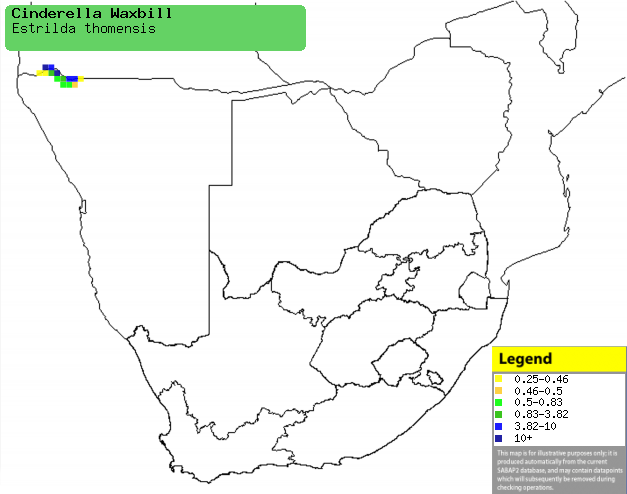|
Estrilda thomensis (Cinderella
waxbill)
Angolasysie [Afrikaans]; cinderella-astrild [Dutch];
Astrild de Sao Tomé [French]; Cinderella-schönbürzel [German];
Bico-de-lacre-cinzento-angolano [Portuguese]
Life
> Eukaryotes >
Opisthokonta
> Metazoa (animals) >
Bilateria >
Deuterostomia > Chordata >
Craniata > Vertebrata (vertebrates) > Gnathostomata (jawed
vertebrates) > Teleostomi (teleost fish) > Osteichthyes (bony fish) > Class:
Sarcopterygii (lobe-finned
fish) > Stegocephalia (terrestrial
vertebrates) > Tetrapoda
(four-legged vertebrates) > Reptiliomorpha > Amniota >
Reptilia (reptiles) >
Romeriida > Diapsida > Archosauromorpha > Archosauria >
Dinosauria
(dinosaurs) > Saurischia > Theropoda (bipedal predatory dinosaurs) >
Coelurosauria > Maniraptora >Aves
(birds) > Order: Passeriformes
> Family: Estrildidae
Distribution and habitat
Endemic to western Angola and the north-western extreme of
Namibia, generally preferring arid Mopane (Colososphermum mopane)
woodland as well as riverine woodland along the Cunene River and its
tributaries, rarely occurring in gardens and dry Acacia veld.
|
 |
|
Distribution of Cinderella waxbill in southern Africa,
based on statistical smoothing of the records from first SA Bird Atlas
Project (©
Animal Demography unit, University of
Cape Town; smoothing by Birgit Erni and Francesca Little). Colours range
from dark blue (most common) through to yellow (least common). |
Food
It mainly eats seeds taken directly from grass
inflorescences, supplemented with small insects and nectar. The following food items have been recorded
in its diet:
- Plants
- grass seeds
- nectar
- Euclea divinorum (Magic guarri)
- Gymnosporia buxiifolia (Common spikethorn)
- Insects
Breeding
- Nothing is known about its breeding habits in the wild, so all of the
following information is recorded in captivity.
- The nest is a large grass ball with a fairly long entrance tunnel,
sometimes with a false nest at the top which the male roosts in.
- It has been recorded to lay three or four eggs (from only two
observations), which are incubated for about 12-14 days.
- The chicks are fed by both parents, leaving the nest after about 17-21
days and becoming fully independent about 10 days later.
Threats
Near-threatened, due its limited distribution range
and destruction of its favoured habitat along the Cunene River and its
tributaries, mainly from deforestation, overgrazing and over-utilisation of
water.
References
-
Hockey PAR, Dean WRJ and Ryan PG 2005. Roberts
- Birds of southern Africa, VIIth ed. The Trustees of the John Voelcker
Bird Book Fund, Cape Town.
|
